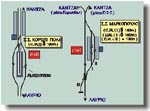 Customer: Greek Railways Orhanisation
Customer: Greek Railways Orhanisation
Duration: December 1996 – December 1997
The study was assigned in 1996 by the Ministry of Environment, Physical Planning and Public Works. Previously, a traffic study was carried out examining the following issues:
• Basic operational characteristics of the rail axis.
• Forecasts for the target year (2015) of the transport demand.
• Multicriteria analysis of four alternative scenarios regarding the routing and the operation of the rail link Katzas-Lavrio-Airport of Spata.
The objectives of this study (feasibility study) were the following:
• Technical and economic analysis of the optimum scenario.
• Forecasts of the passenger traffic demand based on updated data because of the changes which occurred regarding the identification of the target year and the sectionally implementation of the scheme.
• Quantification of the optimum scenario characteristics. These figures would also be used during the economic feasibility and environmental impacts studies.
The social benefit was estimated for three alternative scenarios (for different traffic volumes). The evaluation of the investment was based on the criteria of the Net Present Value.
The NPV was found to be 32.396 million drs. The analysis of the NPV »sensitivity» showed that its value remains positive regardless of the fares increases/reductions, of the total cost of the investment. So, it is concluded that the scheme should be implemented.
Role of TREDIT:
– Forecasts of the passenger traffic demand for the target tears 2005 and 2010 in the links which operate in the different phases of implementation.
– Determination of the operational characteristics and estimation of the operational costs.
– Determination of the methodology which was followed for the economic and technical evaluation of the scheme and the presentation of the results for the target years Cost-benefit analysis
– Investment effectiveness calculation
– Sensibility analysis for the investment
